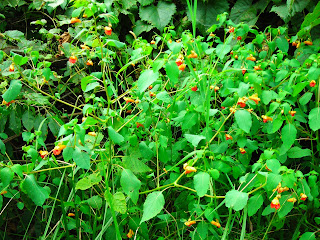After the Fourth of July, exquisite
blossoms of Queen Anne’s Lace began nodding in the breezes and were
particularly prominent along the edge of the wild tangle of trees, brush, and
weeds behind my barn. To my way of thinking, few flowers rival the intricately
constructed blooms of Queen Anne’s Lace. I always include them in my
arrangements of cut flowers, and they are star performers in such rôles.
Throughout the next three weeks, more and more long stems culminating in
doilies of white embroidery came to decorate my flower beds, where I permit
many to grow, and to ornament the brambly zones of my property.
 |
|
Bee
Balm, Painting by L. A. Simonsen, in Wild
Flowers
Adapted
by Asa Don Dickinson from Nature’s Garden
By
Neltje Blanchan (Doubleday, 1917, 1926)
|
Also in early July, the Scarlet
Pimpernel opened its tiny salmon-red blossoms beside a drainage pipe near the
road in front of my house. I refrain from touching the plant because I am told
that its sap can cause a rash. The color of the petals catches the eye and
inspires the appreciation. Scarlet Pimpernel is said to spread easily, but mine
has not done so, perhaps because I routinely mow the grass close to the
drainage pipe. Even though the flowers are minuscule, they may be seen from a
distance, thanks to their extraordinary color.
 |
|
Oswego-Tea,
Photo by Russell Tinling Pansie
In
Norman Taylor’s Wild Flower Gardening
(D.
Van Nostrand, 1955)
|
At the same time, Wild Bergamot, or Bee Balm, suddenly
bloomed in a sunny corner of a disorderly band of growth on high ground above
my creek. The shape of its lavender flowers (Mine were lavender, not red.) reminded me of coconut macaroons!
What a treat to discover such splendid color bobbing to the pranks of
capricious zephyrs! Wild Bergamot can be purchased for flower beds, but, as its
name implies, it can be wild. I suspect that mine was originally among the
seeds of wildflowers that I scattered years ago in a vain attempt to start what
I hoped would be a spectacular summer display. Almost none of the seeds grew!
In years since, I have thought that the Red Clover, Oxeye Sunflower, and Wild
Bergamot might have been among the hapless seeds that I so carelessly tossed
over a grassy spot near my orchard.
 |
|
Morning-Glory,
Painting by L. A. Simonsen in Wild
Flowers
Adapted
by Asa Don Dickinson from Nature’s Garden
By
Neltje Blanchan (Doubleday, 1917, 1926)
|
How there came to be a thriving
Morning Glory vine in the midst of my vegetable garden is beyond me! Yet there
it was with big blue flowers spreading across a corner of my flower border.
 |
| Morning Glory Blooming in a Sunny Corner of My Vegetable Garden |
Then there appeared one of my
favorite wildflowers: the Spotted Touch-Me-Not! Amid masses of light green
foliage in the far corner of my land, the mottled orange trumpets faced the
morning sun from their location along a thicket bordering the creek. Every
year, I watch for the leaves because I want this loveliest of wildflowers to
spread. After the bloom cycle, I have tried to help the seeds to scatter more
broadly but to no avail; I have realized that the plants must seed themselves
without my intervention. This year, I have more billowing clusters of
Touch-Me-Not blooms than I have enjoyed in recent years, so they must be
gradually spreading, much to my delight!
 |
| Spotted Touch-Me-Not, One of My Favorite Wildflowers |
With such
spectacular displays of wildflowers, I echo these lines by Robert Browning: “God’s in His heaven—
/ All’s right with the world!”

No comments:
Post a Comment